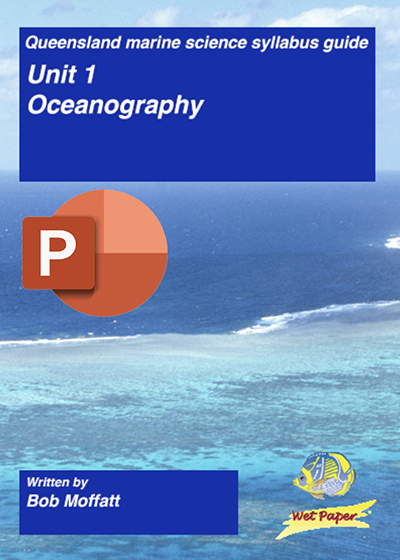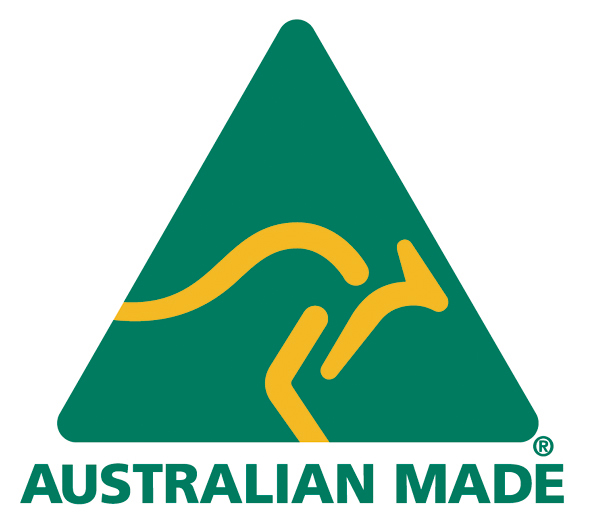Oceanography for senior students power points

ISBN : 978-1-86283-1-171-1 (E Pub)
Published Date : 01 December 2024
Product Code : F 46PP
Format : Zip file of 36 power points with licence agreement
By Bob Moffatt
Wet Paper publications non-commercial school licence
The publisher and author/s of this pdf file grant to the school a revocable, non-exclusive, non-transferable right and licence to use the content, exercises, lab and field work lesson notes within the school for educational purposes only.
Yearly record keeping
To ensure fair payment is made to collecting societies, educational institutions are to record the digital ISBN above.
- To do this go to the school office and ask the IT department or whoever looks after digital book licences to record the ISBN in the school digital library licence catalogue.
Copyright
Except as permitted by the Copyright Act 1968 (Cth), you may not reproduce any of the contents of this publication, without the written permission of the copyright owner.
The title to, and intellectual property rests with the publisher's author/s, illustrators, photographers and design consultants and nothing in the agreement should be construed as transferring those rights to the school.
Educational exemption
There are exemptions under the Act that allow educational and government use of text, images and music scores for educational purposes.
These exemptions are in Part VB of the Copyright Act 1968 (Cth), where you are entitled to reproduce or communicate 10% of the words or one chapter from this file for educational use within your school. If you wish to reproduce or communicate MORE than 10% contact the copyright owner.
For more information, see www.copyright.com.au and www.copyright.org.au.
Teachers Information
Suitable for Unit 1 Qld Marine Science Syllabus topics 1 and 2
Details
1112 power point slides with activities, experiments and projects for the new syllabus.
Note: This is a 440 Mb file with 36 power points containing over 1000 slides of Bob's original work.
Citation
This publication should be cited and acknowledged as:
Queensland Marine Science Syllabus Guide V1.2 Unit 1 Oceanography, written by Bob Moffatt, Wet Paper Publications 2019
Teachers Information
Self-funding legacy
This Wet Paper legacy project is self-funded from the sales of a small number of books to allow future marine educators to take our original ideas from 2021 and make them relevant in 5, 10 or even 20 years in the future.
Copyright
The Moffatt Group Australia Pty Ltd 2020.
Price
The publication is FREE.
Support Material
Gail Riches workbooks
Contents
Unit 1: Oceanography
Topic 1. Ocean planet
A. Oceanography
Power point topics
T001 Bathymetric features
T002 Marine geology models
T003 Biogeochemical cycles
Syllabus subject matter statements
T 001 Describe the bathymetric features of the ocean floor, including the continental margin, ocean-basin floor, deep-sea trenches, mid-ocean ridges and abyssal plain
T 002 Apply models to understand the geological features of the Earth (e.g. sea floor modelling, tectonic plate movements, coastal landforms, stratigraphy)
T 003 Describe the processes of the following cycles: water, carbon and oxygen.
B. Ocean currents
Power point topics
T004 Currents and driving forces
T005 Ocean water, heat and nutrient distribution
T006 Seawater properties
T007 Ocean stratification
T008 Oxygen minimum zone
T009 Deep ocean circulation
Syllabus subject matter statements
T 004 Describe how surface ocean currents are driven by temperature, wind and gravity
T 005 Describe how water, heat and nutrients are distributed across coastal regions and global ocean basins (e.g. upwelling and downwelling, El Niño and La Niña events, Langmuir circulation, Ekman spiral)
T 006 Describe the physical and chemical properties of water, including structure, hydrogen bonding, polarity, action as a solvent, heat capacity and density
T 007 Define thermocline, halocline and pycnocline
T 008 Recognise how thermoclines and nutrients produce the oxygen minimum within the open ocean
T 009 Explain how thermohaline circulation in the deep ocean is affected by salinity and water density.
C. Ocean conservation
Power point topics
T010 Oceans need further investigation
T011 Resources and economic value
Syllabus subject matter statements
T 010 Argue that knowledge of the oceans is limited and requires further investigation
T 011 Understand that the economic development of a nation and the value placed on marine environment, including the Exclusive Economic Zone (EEZ), affects decisions relating to resource management
Topic 2: The dynamic shore
A. Coastlines
Power point titles
T012 Shaping coastlines
T013 Tidal movements
T014 Sand movement
T015 Wave behaviour
T016 Material movements
T017 Coastal erosion
T018 Weather patterns
T019 Wave behaviour
T020 Wave properties
Syllabus subject matter statements
T 012 Identify that coastlines are shaped by a number of factors, including tectonic plate movements, shifts in climate patterns and sea level change, weather patterns, and movement of sediments and water (e.g. waves, currents)
T 013 Recognise tidal movement in terms of gravitational pull, current strength and wave action
T 014 Define sand budget and longshore drift
T 015 Define refraction, reflection and diffraction
T 016 Describe the factors of wave action, wind and longshore drift in the management of the movement of water, nutrients, sand, sediment and pollutants (e.g. oil spills, debris)
T 017 Describe the processes of coastal erosion (in terms of accretion and erosion)
T 018 Identify the factors between the atmosphere and the oceans that drive weather patterns and climate (e.g. temperature, wind speed and direction, rainfall, breezes, barometric pressure)
T 019 Recall wave formation processes (e.g. fetch, relationship of wave height and type to water depth and wave celerity)
T 020 Explain how the properties of waves are shaped by weather patterns, natural formations and artificial structures (e.g. interference patterns, fetch, wave sets).
B. Coastal impacts
Power point titles
T021 Coastal engineering
T022 Longitudinal studies
T023 Habitat change and succession
T024 Population density data
T025 Types of pollution
Syllabus subject matter statements
T 021 Explain how coastal engineering regulates water or sediment flow, affects currents and impacts the coastline, including marine ecosystems
T 022 Recognise that longitudinal studies allow scientists to observe changes occurring in marine environments (e.g. satellite imagery, aerial photography, field research)
T 023 Identify how organisms populate areas following changes in habitats (e.g. succession)
T 024 Assess population density data of coastal areas to identify the impact on the health of coastal water
T 025 Recall types of pollution of coastal zones, including organic wastes, thermal, toxic compounds, heavy metals, oil, nutrients and pesticides.
C. Coastal conservation and monitoring impacts
Power point titles
T06 Sustainable management practices
T027 Stakeholder education
T028 Pollution sources
T029 Monitoring water pollution
T030 Biochemical oxygen demand
T031 BOD and pollution
T032 Eutrophication
T033 Land management and pollution
T034 Measuring pollution levels
T035 Bio-indicators
T036 Water quality testing
Syllabus subject matter statements
T 026 Define sustainable management practice
T 027 Discuss that the education of stakeholders is essential to encouraging sustainable management practices
T 028 Compare the terms point source and non-point source forms of pollution
T 029 Describe two direct methods of monitoring water pollution levels using an abiotic test (e.g. nitrate, phosphate, heavy metals) or a biotic test (e.g. faecal coliform)
T 030 Define the term biochemical oxygen demand (BOD)
T 031 Describe how BOD is used to indirectly assess water pollution levels
T 032 Define the process of eutrophication
T 033 Identify and describe land management practices that contribute to the health of marine ecosystems, including siltation, algal blooms and agricultural practices
T 034 Describe and explain an indirect method of measuring pollution levels using a biotic index
T 035 Recall a bio-indicator with an example.
T 036 Conduct water quality tests on a water sample (Mandatory practical)




